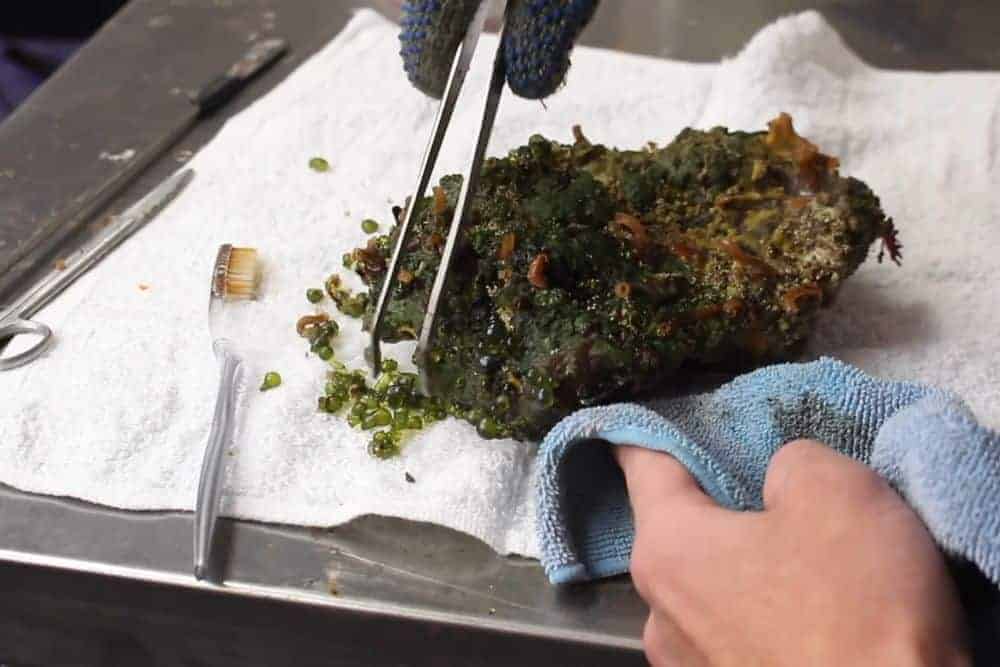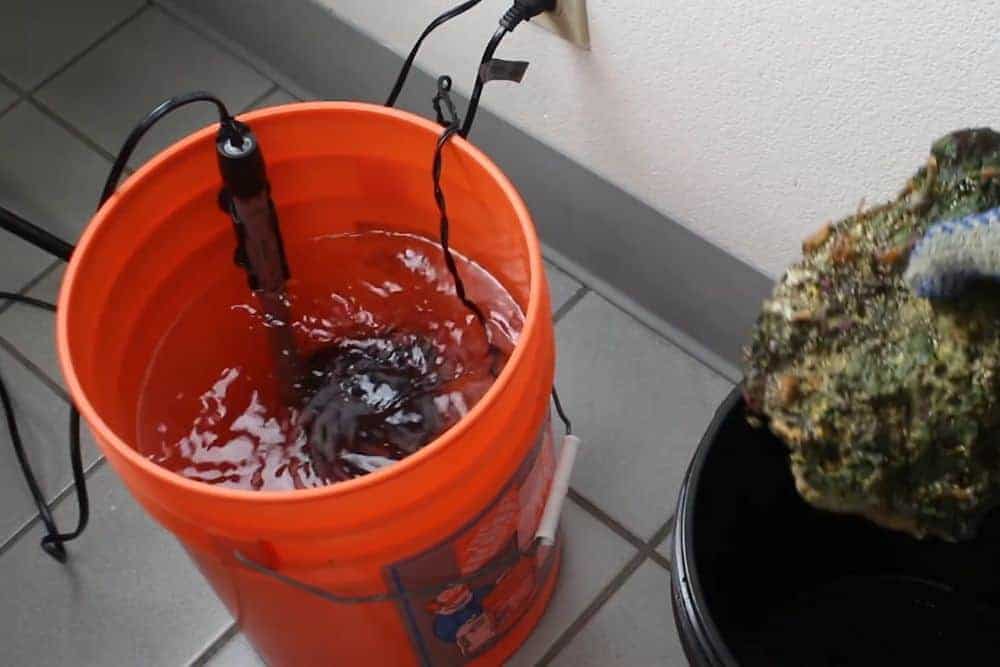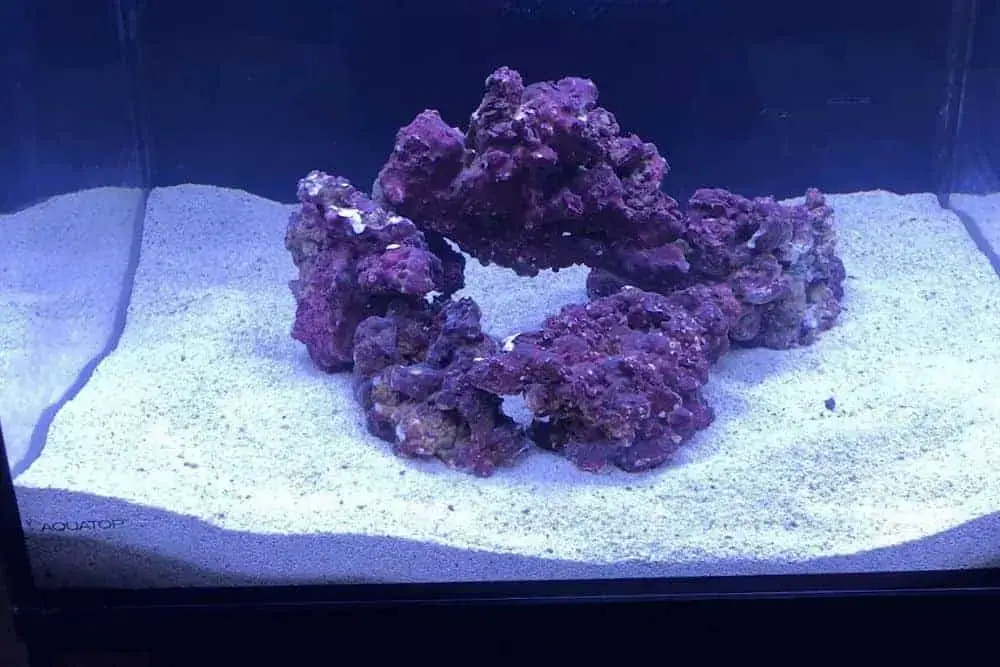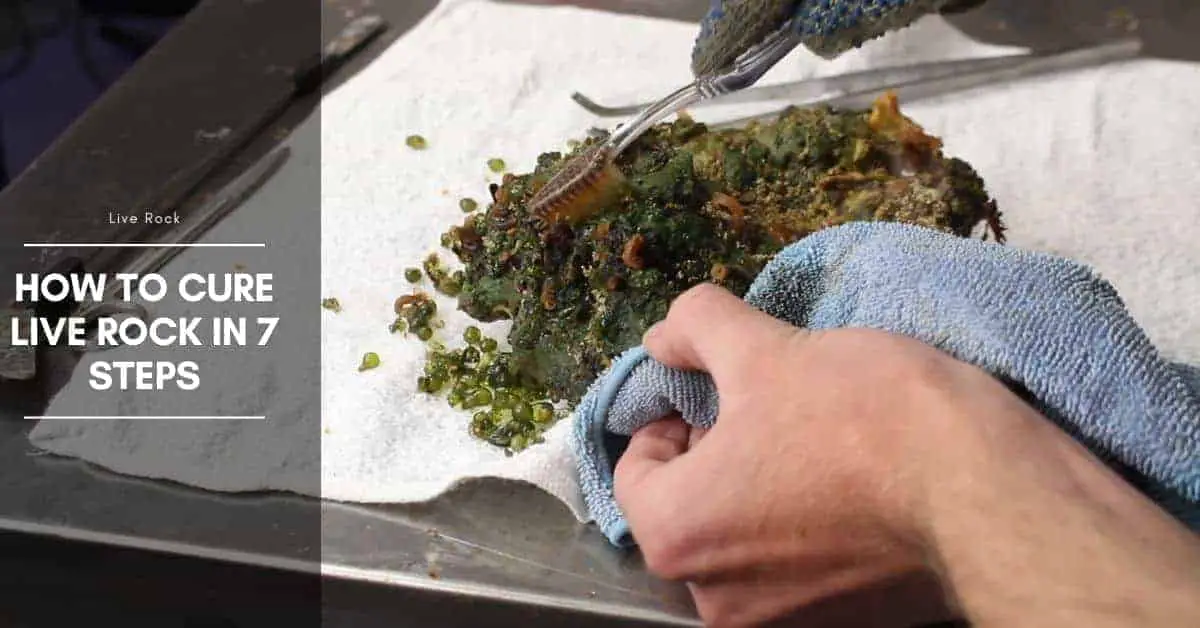The best approach when starting with freshly imported rock is to cure the live rock in a separate container isolated from your living space.
Most home-cured rock is processed in 30-gallon plastic garbage cans or Rubbermaid cattle watering troughs.
Here are the steps for curing live rock
The process can take from two weeks to a month or longer, depending on the initial condition of the rock, the process used, and the water temperature.
- Rinse each incoming piece of rock in clean saltwater mixed to a specific gravity reading of 1.021-1.025. (It can be a bit dilute compared to full-strength seawater, to save money.) This can also be old aquarium water removed during water changes, or new saltwater that has been aged for at least eight hours and brought to 75-82°F.
- Place rinsed pieces in a new plastic garbage can dedicated to aquarium use. Do not pack rock tightly, but rather create a loose stack of rock.
- Cover the rock with saltwater and add a powerhead to create constant water movement and a heater to keep the temperature at 80-82°F. (Curing will take longer at lower temperatures.) Leave the container uncovered for gas exchange.
- Perform 33% water changes daily or 100% water changes every three days.
- When doing water changes, brush away any white or black decaying material and rinse each piece in a bucket of clean saltwater.
- Keep the vat of water out of direct sunlight and do not use any artificial light, which can trigger an algae bloom.
- When the vat passes a “sniff test” with no odor and nitrite readings of zero, the rock can be given a final rinse and moved to an aquarium.

The more you can control ammonia and nitrite in the curing water, the greater will be the survival rate of desirable organisms on and within the rock. An adequately sized protein skimmer will help mitigate the polluting effects of decaying sponges and other matters. A power filter containing a phosphate binder, activated carbon, or a Poly-Filter pad can reduce the toxic effects of ammonia, nitrite, and phosphate.
Tetra AquaSafe Plus, 8.45 Ounces, aquarium Water Conditioner And Dechlorinator, Model Number: 46798162681
$8.49 (as of July 14, 2024 06:58 GMT +03:00 - More infoProduct prices and availability are accurate as of the date/time indicated and are subject to change. Any price and availability information displayed on [relevant Amazon Site(s), as applicable] at the time of purchase will apply to the purchase of this product.)API TAP WATER CONDITIONER Aquarium Water Conditioner 16-Ounce Bottle
(as of July 14, 2024 07:00 GMT +03:00 - More infoProduct prices and availability are accurate as of the date/time indicated and are subject to change. Any price and availability information displayed on [relevant Amazon Site(s), as applicable] at the time of purchase will apply to the purchase of this product.)API STRESS COAT Aquarium Water Conditioner 4-Ounce Bottle (85B)
40% OffFor a beginning aquarist, all this may be more than a bit overwhelming. It can also dramatically increase the cost of that “cheap” rock. An advanced aquarist needing to build a large reefscape with many pounds of rock is much more likely to have the time, equipment, and experience to cure specially ordered rock properly and efficiently.

Do not buy rock from an unknown source. Some cheap live rock is actually shipped by boat, rather than air freight, from Fiji and other places, and may have been held in a hot, dry cargo container for three to six weeks. It is sometimes known as “Boat Rock,” and it is no bargain. Similarly, beware of free or pass-along rock from someone tearing down a tank. Rock that has been exposed to fast-spreading fish parasites such as Amyloodinium ocellatum (sometimes called Marine Ich), Cryptocaryon irritans, or Brooklynella hostilis may be carrying cysts that can hatch and spread disease to your system.
Live rock exposed to copper sulfate and other aquarium drug treatments may be contaminated and could be a future source of trouble for delicate invertebrates. Avoid any live rock that has been through a tank “wipe-out” event unless you are prepared to bleach it, give it a long soak in fresh water, and essentially start with dead, sterile rock.

Many distributors and Internet sellers offer types of cured rock that has been cleaned after collection, but that may still be very capable of going through an active die-offstage when it reaches the local store or hobbyist. Any newly arrived rock should be regarded with suspicion until it proves to be clean, odor-free, and not still producing ammonia and nitrite.
If in doubt, find a local store you know and trust and specify only rock that has been in their tanks for a full month and is “completely cured.” Buying directly from your livestock retailer allows you to hand-select each piece, looking for attractive shapes, coralline algae growth in shades of pink or red, and sometimes attached small coral colonies, live clams or other mollusks, macroalgae, or colorful sponges. Again, avoid any rock that fails a “sniff test” or that has fungus-like patches of white, indicating active decay of encrusting organisms, often sponges.

Hi, my name is Sean, and I’m the primary writer on the site. I’m blogging mostly about freshwater and saltwater aquariums, fish, invertebrates, and plants. I’m experienced in the fishkeeping hobby for many years. Over the years I have kept many tanks, and have recently begun getting more serious in wanting to become a professional aquarist. All my knowledge comes from experience and reading forums and a lot of informative sites. In pursuit of becoming a professional, I also want to inspire as many people as I can to pick up this hobby and keep the public interest growing.
Read more about Sean.
Please join also my Facebook group.



















